JoSelle Vanderhooft penned this review.
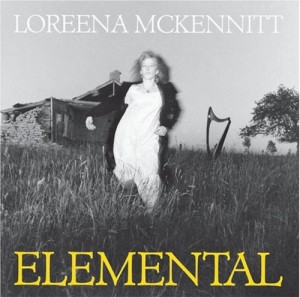 From her beginnings in the mid 1980s selling self-produced tapes from her car and by mail order, to international stardom — Loreena McKennitt has come a long way in her long career. For those just discovering her music with the release of An Ancient Muse, here follows a tour through this incredible singer’s previous recordings, all released on her independent recording label, Quinlan Road.
From her beginnings in the mid 1980s selling self-produced tapes from her car and by mail order, to international stardom — Loreena McKennitt has come a long way in her long career. For those just discovering her music with the release of An Ancient Muse, here follows a tour through this incredible singer’s previous recordings, all released on her independent recording label, Quinlan Road.
Elemental: Unlike her complex and culture-blending recordings of the 1990s and beyond, the orchestrations on McKennitt’s first studio album are comparatively simple; just her soaring mezzo-soprano accompanied by troubadour harp, accordion, ckello or guitar. Though this may be startling, even off-putting to listeners more familiar with her later albums, Elemental should not be dismissed as a worthy first effort. The music is visionary, the sound quality clear (particularly after the 1994 re-mastering for CD), and McKennitt’s re-arrangements of such traditional songs as “Come by the Hills”, “Banks of Claudy” and “Blacksmith” masterful. This recording also establishes McKennitt’s practice of setting poetry to music with such offerings as Padraic Collum’s 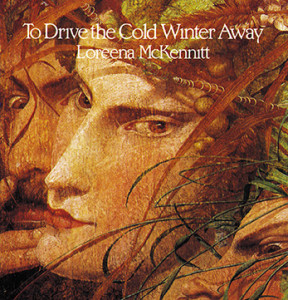 “She Moved Through the Fair”, W.B. Yeats’ “The Stolen Child” and a stirring rendition of “Lullaby”, a William Blake poem originally used in the Stratford Festival’s 1983 production of the Elliot Hayes play, Blake. The highlight of the CD, however, is the duet “Carrighfergus”, a song about a lovelorn, aging Irishman sung with Cedric Smith.
“She Moved Through the Fair”, W.B. Yeats’ “The Stolen Child” and a stirring rendition of “Lullaby”, a William Blake poem originally used in the Stratford Festival’s 1983 production of the Elliot Hayes play, Blake. The highlight of the CD, however, is the duet “Carrighfergus”, a song about a lovelorn, aging Irishman sung with Cedric Smith.
To Drive the Cold Winter Away: McKennitt’s first Christmas-themed album traverses similar musical territory to that of Elemental — in this case a selection of lesser-known English, Irish and Scottish carols all rendered with her ear for Celtic rhythm and embellishment. The fact that many were recorded in European churches and abbeys further adds to the feel that the listener has been transported into the divine. Scattered among such seasonal gems as “Let Us the Infant Greet”, “The Wexford Carol” and “In Praise of Christmas” are McKennitt’s own astonishing instrumentals “The Stockford Carol”, “Banquet Hall” and a meditative arrangement of Archibald
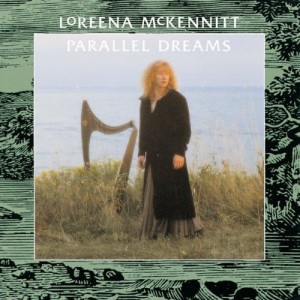 Lampman’s poem “Snow”. The album’s only true a capella track “Balulalow” (a Scottish word for lullaby) is a fine example of the heights to which McKennitt’s voice can soar; alas, thanks to the acoustics of Glenstal Abbey, it is also difficult to hear, at least on the 1994 remaster of the original tape. This is a pity, especially as the architecture also produces ethereal echoes, making McKennitt sound as if she were singing with the angels. Though especially good to play during November and December, this CD can be enjoyed all year.
Lampman’s poem “Snow”. The album’s only true a capella track “Balulalow” (a Scottish word for lullaby) is a fine example of the heights to which McKennitt’s voice can soar; alas, thanks to the acoustics of Glenstal Abbey, it is also difficult to hear, at least on the 1994 remaster of the original tape. This is a pity, especially as the architecture also produces ethereal echoes, making McKennitt sound as if she were singing with the angels. Though especially good to play during November and December, this CD can be enjoyed all year.
Parallel Dreams: McKennitt’s third album is a transitional work, a bridge between the harp, cello and violin simplicity of her earlier recordings and the multi-instrumental, multi-ethnic sound she would embrace by the 1990s. The result, however, is not an awkward train wreck of sound and fury, to which many sophomore and junior efforts fall prey, but a sophisticated and inventive collection of songs (all centered in some way around dreams) that holds  up to repeat listenings. More than any other album, Parallel Dreams explores the Celtic sound and imagery at the core of McKennitt’s music, from traditional Irish ballads like “Standing Stones” and the Romeo and Juliet tale “Annachie Gordon” to original compositions like “Samain Night” and the haunting, wordless “Ancient Pines” (used in the film Goddess Remembered). Notably, this is also her first album to noticeably blend the music of two different cultures in the lively “Huron ‘Beltane’ Fire Dance”, a tribute to the Huron (Wyandot) Native American and Celtic cultures and the importance both placed upon dreams.
up to repeat listenings. More than any other album, Parallel Dreams explores the Celtic sound and imagery at the core of McKennitt’s music, from traditional Irish ballads like “Standing Stones” and the Romeo and Juliet tale “Annachie Gordon” to original compositions like “Samain Night” and the haunting, wordless “Ancient Pines” (used in the film Goddess Remembered). Notably, this is also her first album to noticeably blend the music of two different cultures in the lively “Huron ‘Beltane’ Fire Dance”, a tribute to the Huron (Wyandot) Native American and Celtic cultures and the importance both placed upon dreams.
The Visit: McKennitt’s first widely distributed CD was also her first major foray into the music of non-Celtic cultures, and thus the first time her eclectic music was classified as world. There is a distinctly Japanese flair to the opening track “All Souls Night”, a piece inspired by imagery of the Celtic new year bonfire, and the Japanese tradition of  commemorating departed souls with lanterns set afloat on rivers leading to the ocean. “Tango to Evora” and “Between the Shadows (Persian Shadows)” also utilizes Eastern instruments like the balalaika which McKennitt will use in her later recordings. McKennitt also shows her playful side in her rendition of Henry VIII’s “Greensleeves”, which she recorded in one take as something of a curiosity that she never intended to release. Here, her ethereal voice somehow channels the grit, melancholy and cadence of Tom Waits’ best ballads like “Time” and “Who Are You” — according to McKennitt’s liner notes, this was a deliberate choice.
commemorating departed souls with lanterns set afloat on rivers leading to the ocean. “Tango to Evora” and “Between the Shadows (Persian Shadows)” also utilizes Eastern instruments like the balalaika which McKennitt will use in her later recordings. McKennitt also shows her playful side in her rendition of Henry VIII’s “Greensleeves”, which she recorded in one take as something of a curiosity that she never intended to release. Here, her ethereal voice somehow channels the grit, melancholy and cadence of Tom Waits’ best ballads like “Time” and “Who Are You” — according to McKennitt’s liner notes, this was a deliberate choice.
The Mask and the Mirror: Possibly McKennitt’s finest work to date, this recording’s musical terrain is as vast as the questions the album seeks to answer: “…who was God? And what is religion, what spirituality?” As the map on the CD booklet’s inside cover may indicate, The Mask and the Mirror is set musically in Spain and Northern Africa, the historical crossroads of Judaism, Christianity and Islam. This lively debate between cultures 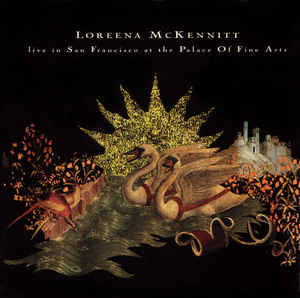 permeates songs like “Marakesh Night Market” and the monumental “The Mystic’s Dream”, in which Uilleann pipes wail over a background of nais, ouds and tambouras. The album’s true standout, and one of McKennitt’s best songs yet, is “The Dark Night of the Soul”, a nuanced adaptation of St. John of the Cross’ famous mystical poem and the most sensual translation of the work yet published.
permeates songs like “Marakesh Night Market” and the monumental “The Mystic’s Dream”, in which Uilleann pipes wail over a background of nais, ouds and tambouras. The album’s true standout, and one of McKennitt’s best songs yet, is “The Dark Night of the Soul”, a nuanced adaptation of St. John of the Cross’ famous mystical poem and the most sensual translation of the work yet published.
Live in San Francisco: These highlights from one of McKennitt’s all-too-rare US appearances are not well-known, even among her most devoted fans. This is unfortunate, as this little CD holds up quite well to 1999’s Live in Toronto and Paris. The six selections from Elemental, The Visit and The Mask and the Mirror are just as dynamic and engaging as their original versions, yet they are distinct enough not to feel repetitious. Thanks, perhaps, to her earlier work with the Stratford Festival, McKennitt is a cite live performer who well understands the
difference between the dynamics of studio and stage. Her expertise shines through, particularly in tracks like the lively “Santiago” and “The Bonny Swans”, which she slows and scales down making it an even more intimate experience.
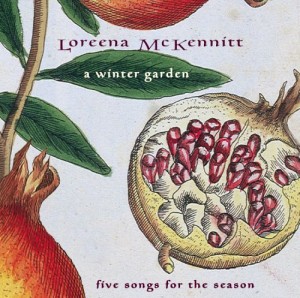 A Winter Garden: Five Songs for the Season: McKennitt’s second Christmas recording began life as an exercise at Peter Gabriel’s Real World Studios. Recorded in just five days, A Winter Garden showcases McKennitt’s burgeoning interest in Middle Eastern music in her spirited arrangements of old favorites like “Good King Wenceslas” and “God Rest Ye Merry, Gentlemen”. The album also contains a re-make of “Snow” which is even more robust and dreamy than the original on To Drive the Cold Winter Away. The English lyric “The Seeds of Love”, the only track with no connections to Yuletide or even winter, sounds as if it had been lifted straight from the thirteenth century.
A Winter Garden: Five Songs for the Season: McKennitt’s second Christmas recording began life as an exercise at Peter Gabriel’s Real World Studios. Recorded in just five days, A Winter Garden showcases McKennitt’s burgeoning interest in Middle Eastern music in her spirited arrangements of old favorites like “Good King Wenceslas” and “God Rest Ye Merry, Gentlemen”. The album also contains a re-make of “Snow” which is even more robust and dreamy than the original on To Drive the Cold Winter Away. The English lyric “The Seeds of Love”, the only track with no connections to Yuletide or even winter, sounds as if it had been lifted straight from the thirteenth century.
 The Book of Secrets: Unsurprisingly, given the international scope of its research and music, McKennitt’s last studio album before her nine year hiatus gained her international attention including a Billboard International Achievement Award, and a Top 20 Billboard slot for the album’s second track, “The Mummer’s Dance” that would later undergo a popular, if somewhat watered-down, radio remix. Perhaps McKennitt’s most eclectic album along with 2006’s An Ancient Muse it includes tracks such as the infectious “Marco Polo”, “Dante’s Prayer”, an homage to the spirit of the Divine Comedy’s writer, and the graceful tribute to Renaissance Venice “La Serenissima”. The album’s most daring track, however, is “The Highwayman”, which not only encapsulates the adventurous, chivalrous spirit of Alfred Noyes’ poem but sustains it throughout its more than ten minute run time.
The Book of Secrets: Unsurprisingly, given the international scope of its research and music, McKennitt’s last studio album before her nine year hiatus gained her international attention including a Billboard International Achievement Award, and a Top 20 Billboard slot for the album’s second track, “The Mummer’s Dance” that would later undergo a popular, if somewhat watered-down, radio remix. Perhaps McKennitt’s most eclectic album along with 2006’s An Ancient Muse it includes tracks such as the infectious “Marco Polo”, “Dante’s Prayer”, an homage to the spirit of the Divine Comedy’s writer, and the graceful tribute to Renaissance Venice “La Serenissima”. The album’s most daring track, however, is “The Highwayman”, which not only encapsulates the adventurous, chivalrous spirit of Alfred Noyes’ poem but sustains it throughout its more than ten minute run time.
(Quinlan Road, 1985 – 1997)
